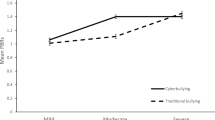Abstract
Cyberbullying, a modern form of bullying performed using electronic forms of contact (e.g., SMS, MMS, Facebook, YouTube), has been considered as being worse than traditional bullying in its consequences for the victim. This difference was mainly attributed to some specific aspect that are believed to distinguish cyberbullying from traditional bullying: an increased potential for a large audience, an increased potential for anonymous bullying, lower levels of direct feedback, decreased time and space limits, and lower levels of supervision. The present studies investigated the relative importance of medium (traditional vs. cyber), publicity (public vs. private), and bully’s anonymity (anonymous vs. not anonymous) for the perceived severity of hypothetical bullying scenarios among a sample of Swiss seventh- and eight-graders (study 1: 49 % female, mean age = 13.7; study 2: 49 % female, mean age = 14.2). Participants ranked a set of hypothetical bullying scenarios from the most severe one to the least severe one. The scenarios were experimentally manipulated based on the aspect of medium and publicity (study 1), and medium and anonymity (study 2). Results showed that public scenarios were perceived as worse than private ones, and that anonymous scenarios were perceived as worse than not anonymous ones. Cyber scenarios generally were perceived as worse than traditional ones, although effect sizes were found to be small. These results suggest that the role of medium is secondary to the role of publicity and anonymity when it comes to evaluating bullying severity. Therefore, cyberbullying is not a priori perceived as worse than traditional bullying. Implications of the results for cyberbullying prevention and intervention are discussed.




Similar content being viewed by others
References
Asarnow, J. R., Carlson, G. A., & Guthrie, D. (1987). Coping strategies, self-perceptions, hopelessness, and perceived family environments in depressed and suicidal children. Journal of Consulting and Clinical Psychology, 55, 361–366.
Badiuk, B. B. (2006). Cyberbullying in the global village: The worldwide emergence of high-tech as a weapon for bullies. In A. Green (Ed.), Education students’ anthology (Vol. 9) (pp. 12–16). Winnipeg, MB: Faculty of Education.
Bauman, S. (2009). Cyberbullying in a rural intermediate school: An exploratory study. Journal of Early Adolescence. Retrieved February 02, 2012, from http://jea.sagepub.com/content/early/2009/12/09/0272431609350927.
Blake, P., & Louw, J. (2010). Exploring high school learners’ perceptions of bullying. Journal of Child & Adolescent Mental Health, 22(2), 111–118.
Campbell, M. (2005). Cyber-bullying: An old problem in a new guise? Australian Journal of Guidance and Counselling, 15(1), 68–76.
Craig, W., & Pepler, D. (1997). Observations of bullying and victimization in the schoolyard. Canadian Journal of School Psychology, 13, 41–50.
Craig, W., Pepler, D., & Atlas, R. (2000). Observations of bullying in the playground and the classroom. School Psychology International, 21, 22–36.
Dooley, J. J., Pyzalski, J., & Cross, D. (2009). Cyberbullying versus face-to-face bullying: A theoretical and conceptual review. Journal of Psychology, 217(4), 182–188.
Hawkins, D. L., Pepler, D., & Craig, W. (2001). Naturalistic observations of peer interventions in bullying. Social Development, 10, 512–527.
Juvonen, J., & Gross, E. F. (2008). Extending the school grounds? Bullying experiences in cyberspace. Journal of School Health, 78(9), 496–505.
Kowalski, R. M., & Limber, S. (2007). Electronic bullying among middle school students. Journal of Adolescent Health, 41, 22–30.
Kowalski, R. M., Limber, S., & Agatston, P. W. (2008). Cyber bullying: Bullying in the digital age. Malden, MA: Blackwell.
Li, Q., Smith, P. K., & Cross, D. (2012). Research into cyberbullying: Context. In Q. Li, D. Cross, & P. K. Smith (Eds.), Cyberbullying in the global playground: Research from international perspectives (pp. 3–12). Oxford: Blackwell.
Machmutow, K., Perren, S., Sticca, F., & Alsaker, F. D. (2012). Peer victimisation and depressive symptoms: Can specific coping strategies buffer the negative impact of cybervictimisation? Emotional and Behavioral Difficulties, 17(3), 403–420.
Menesini, E., Nocentini, A., Palladino, B. E., Frisén, A., Berne, S., Ortega, R., et al. (2012). Cyberbullying definition among adolescents: A comparison across six European countries. Cyberpsychology, Behavior, and Social Networking, 15(9), 455–463.
Mishna, F., Saini, M., & Solomon, S. (2009). Ongoing and online: Children and youth’s perceptions of cyber bullying. Children and Youth Services Review, 31(12), 1222–1228.
Mitchell, K. J., Finkelhor, D., & Wolak, J. (2003). Victimization of youths on the Internet. Journal of Aggression, Maltreatment & Trauma, 8(1/2), 1–39.
Nocentini, A., Calmaestra, J., Schultze-Krumbholz, A., Scheithauer, H., Ortega, R., & Menesini, E. (2010). Cyberbullying: Labels, behaviors and definition in three European countries. Australian Journal of Guidance and Counselling, 20(02), 129–142.
Olweus, D. (1993). Bullying in schools. What we know and what we can do. Oxford: Blackwell.
Patchin, J. W., & Hinduja, S. (2006). Bullies move beyond the schoolyard: A preliminary look at cyberbullying. Youth Violence and Juvenile Justice, 4(2), 148–169.
Perren, S., & Gutzwiller-Helfenfinger, E. (2012). Cyberbullying and traditional bullying in adolescence: Differential roles of moral disengagement, moral emotions, and moral values. European Journal of Developmental Psychology, 9(2), 195–209.
Roth, S., & Cohen, L. J. (1986). Approach, avoidance, and coping with stress. American Psychologist, 41, 813–819.
Sainio, M., Veenstra, R., Huitsing, G., & Salmivalli, C. (2011). Victims and their defenders: A dyadic approach. International Journal of Behavioral Development, 35, 144–151.
Salmivalli, C., Kärnä, A., & Poskiparta, E. (2010). Development, evaluation, and diffusion of a national antibullying program, KiVa. In B. Doll, W. Pfohl, & J. Yoon (Eds.), Handbook of youth prevention science (pp. 238–252). New York: Routledge.
Salmivalli, C., Voeten, M., & Poskiparta, E. (2011). Bystanders matter: Associations between reinforcing, defending, and the frequency of bullying behavior in classrooms. Journal of Clinical Child and Adolescent Psychology, 40(5), 68–676.
Seiffge-Krenke, I., & Klessinger, N. (2000). Long-term effects of avoidant coping on adolescents’ depressive symptoms. Journal of Youth and Adolescence, 29, 617–630.
Slonje, R., & Smith, P. K. (2008). Cyberbullying: Another main type of bullying? Scandinavian Journal of Psychology, 49, 147–154.
Smith, P. K. (2011). Cyberbullying and cyber aggression. In S. R. Jimerson, A. B. Nickerson, M. J. Mayer, & M. J. Furlong (Eds.), Handbook of school violence and school safety: International research and practice. New York: Routledge.
Smith, P. K., Mahdavi, J., Carvalho, M., Fisher, S., Russell, S., & Tippet, N. (2008). Cyberbullying: Its nature and impact in secondary school pupils. Journal of Child Psychology Psychiatry, 49, 376–385.
Smith, P. K., & Slonje, R. (2010). Cyberbullying: the nature and extent of a new kind of bullying, in and out of school. In S. Jimerson, S. Swearer, & D. Espelage (Eds.), The international handbook of school bullying (pp. 249–262). New York: Routledge.
Spears, B., Slee, P., Owens, L., & Johnson, B. (2009). Behind the scenes and screens: Insights into the human dimension of covert and cyberbullying. Zeitschrift für Psychologie/Journal of Psychology, 217, 189–196.
Sticca, F., Ruggieri, S., Alsaker, F. D., & Perren, S. (in press). Longitudinal risk factors for cyberbullying in adolescence. Journal of Community and Applied Social Psychology.
Tokunaga, R. (2010). Following you home from school: A critical review and synthesis of research on cyberbullying victimization. Computers in Human Behavior, 26, 277–287.
Vandebosch, H., & Van Cleemput, K. (2008). Defining cyberbullying: A qualitative research into the perceptions of youngsters. Cyberpsychology & Behavior, 11(4), 499–503.
Willemse, I., Waller, G., & Süss, D. (2010). JAMES—Jugend. Aktivitäten, Medien—Erhebung Schweiz. Zürcher Hochschule für Angewandte Wissenschaften, Zürich.
Acknowledgments
This study was supported by a grant from the Swiss National Science Foundation (SNF No. 100014_130193/1) to the second author. The authors would like to acknowledge the collaboration of Françoise Alsaker, Ursina Rumetsch, Katja Machmutow and Sabrina Ruggieri, as well as all students involved in data collection. Furthermore, we would like to thank all participants, teachers, and parents for the participation over the whole duration of the study.
Fabio Sticca developed the specific research question and designed the study design and method. He also participated in data collection. Furthermore, he did all data analyses and wrote the first version and the revisions of the paper. Sonja Perren was principal investigator of the netTEEN study. She supervised data collection and collaborated in the development of the specific method. She reviewed and supervised the process of data analysis and manuscript writing. Both authors read and approved the final manuscript.
Author information
Authors and Affiliations
Corresponding author
Rights and permissions
About this article
Cite this article
Sticca, F., Perren, S. Is Cyberbullying Worse than Traditional Bullying? Examining the Differential Roles of Medium, Publicity, and Anonymity for the Perceived Severity of Bullying. J Youth Adolescence 42, 739–750 (2013). https://doi.org/10.1007/s10964-012-9867-3
Received:
Accepted:
Published:
Issue Date:
DOI: https://doi.org/10.1007/s10964-012-9867-3




